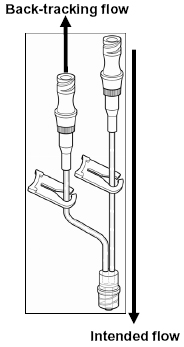Intravenous (IV) extension sets with multiple ports - risk of backtracking
(All brands) risk of back-tracking when an IV line has multiple access ports, which can lead to under-infusion or bolus delivery of IV drugs. (MDA/2010/073)
Device

Image of Intravenous (IV) extension sets.
Intravenous (IV) extension sets with multiple ports: all brands.
All IV lines with multiple ports that will allow fluid to flow in both directions:
- multi-lumen IV extension sets
- IV administration sets with side port/Y-site
- IV multi-way connectors such as stopcocks
- Y-connectors
- manifolds.
This issue is not limited to any particular manufacturer or model.
Problem
Risk of back-tracking when an IV line has multiple access ports. This can lead to under-infusion or bolus delivery of IV drugs.
The MHRA continues to receive reports of incidents involving intravenous (IV) extension sets with multiple ports. These incidents have led to serious consequences eg patients receiving an inadvertent bolus of anaesthetic agent due to back-tracking, resulting in respiratory arrest.
When more than one IV line is connected to a single access point, back-tracking of fluids can occur if one line has no flow or a slower flow of fluid running through it. The fluid will back-track and take the path of least resistance. This can also occur during occlusions. If a downstream occlusion occurs when an infusion pump is being used, the occlusion alarm may not be activated.
Such back-tracking can lead to bolus delivery when: flow in the line is increased; or the line is flushed; or the occlusion is released.
Action
- Consider if an IV extension set with multiple ports is appropriate for your intended use and be aware of alternatives.
- Where appropriate, consider using IV lines with one-way valves to prevent back-tracking (examples of one-way valves are: check, nonreturn or anti-reflux valves or anti-siphon/anti free-flow valves).
- Apply clamps (where available) to lines not in use.
- Be aware that needle-free connectors are not one-way valves and will allow back-tracking when connected to IV devices.
- This MDA supersedes MDA/2007/089.
Distribution
This MDA has been distributed to:
- NHS trusts in England (chief executives)
- HSC trusts in Northern Ireland (chief executives)
- NHS boards in Scotland (chief executives)
- NHS boards and trusts in Wales (chief executives)
- Primary care trusts in England (chief executives)
Onward distribution
Please bring this notice to the attention of all who need to know or be aware of it. This may include distribution by:
Trusts to:
CAS and SABS (NI) liaison officers for onward distribution to all relevant staff including:
- Accident and emergency departments
- All clinical departments
- All wards
- Ambulance services directors
- Ambulance staff
- Anaesthesia, directors of
- Chief pharmacists
- Clinical governance leads
- Hospital at home units
- Intensive care units
- IV nurse specialists
- Medical directors
- Neonatal nurse specialists
- Nursing executive directors
- Nutritional nurse specialists
- Outpatient clinics
- Outpatient theatre managers
- Palliative care teams
- Paramedics
- Pharmacists
- Radiographer superintendents
- Resuscitation officers and trainers
- Risk managers
- Supplies managers
- Theatre managers
Establishments registered with the Care Quality Commission (CQC) (England only) to:
The MHRA considers this information to be important to:
- Adult placement
- Care homes providing nursing care (adults)
- Hospices
- Hospitals in the independent sector
- Independent treatment centres
- Private medical practitioners
Primary care trusts to:
CAS liaison officers for onward distribution to all relevant staff including:
- Community children’s nurses
- Community hospitals
- Community midwives
- Community nurses
- District nurses
- Nutritional nurse specialists
- Palliative care teams
- NHS walk in centres
Feedback
If you have any comments or feedback on this Medical Device Alert, please email us at: dts@mhra.gsi.gov.uk
England
If you are in England, please send enquiries about this notice to the MHRA, quoting reference number MDA/2010/073 or 2010/002/023/601/003.
Technical aspects
Dr Louise Mulroy or Mrs Nicole Small
Medicines & Healthcare products Regulatory Agency
Market Towers
1 Nine Elms Lane
London
SW8 5NQ
Tel: 020 7084 3344
Fax: 020 7084 3565
Email: louise.mulroy@mhra.gsi.gov.uk or nicole.small@mhra.gsi.gov.uk
Clinical aspects
Dr Susanne Ludgate
Medicines & Healthcare products Regulatory Agency
Market Towers
1 Nine Elms Lane
London
SW8 5NQ
Tel: 020 7084 3123
Fax: 020 7084 3111
Email: susanne.ludgate@mhra.gsi.gov.uk
How to report adverse incidents
Please report via our website: Reporting adverse incidents involving medical devices.
Further information about CAS can be found on the Central Alerting System website .
Northern Ireland
Alerts in Northern Ireland will continue to be distributed via the NI SABS system.
Enquiries and adverse incident reports in Northern Ireland should be addressed to:
Northern Ireland Adverse Incident Centre
Health Estates Investment Group
Room 17
Annex 6
Castle Buildings
Stormont Estate
Dundonald
BT4 3SQ
Tel: 02890 523 704
Fax: 02890 523 900
Email: NIAIC@dhsspsni.gov.uk
Northern Ireland Adverse Incident Centre (NIAIC)
How to report adverse incidents in Northern Ireland
Please report directly to NIAIC, further information can be found on the NIAIC website .
Further information about SABS can be found on the SABS website .
Scotland
Enquiries and adverse incident reports in Scotland should be addressed to:
Incident Reporting and Investigation Centre
Health Facilities Scotland
NHS National Services Scotland
Gyle Square
1 South Gyle Crescent
Edinburgh
EH12 9EB
Tel: 0131 275 7575
Fax: 0131 314 0722
Email: nss.iric@nhs.net
Health Facilities Scotland - Incident Reporting and Investigation Centre .
Wales
Enquiries in Wales should be addressed to:
Dr Sara Hayes
Senior Medical Officer
Medical Device Alerts
Welsh Assembly Government
Cathays Park
Cardiff
CF10 3NQ
Tel: 029 2082 3922
Email: Haz-Aic@wales.gsi.gov.uk
Download documents